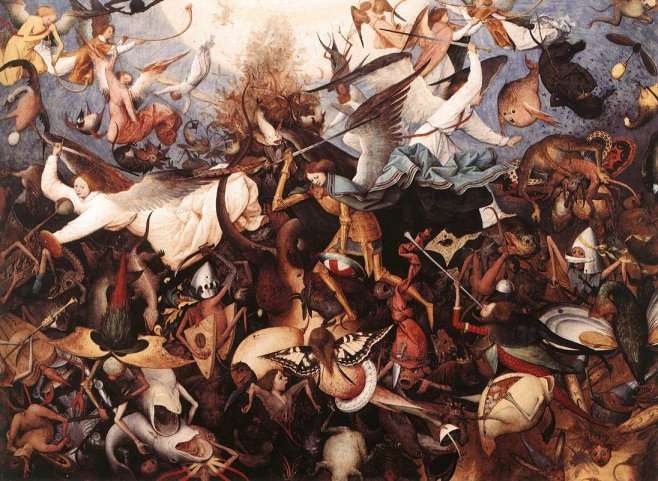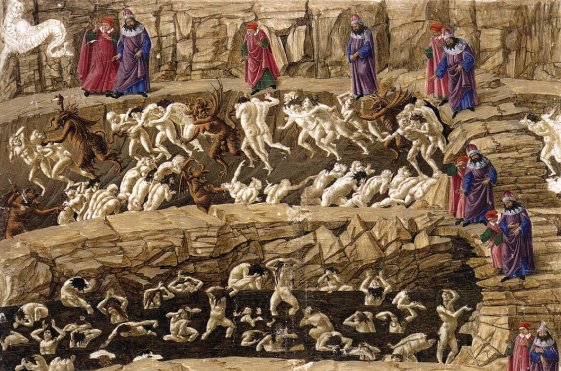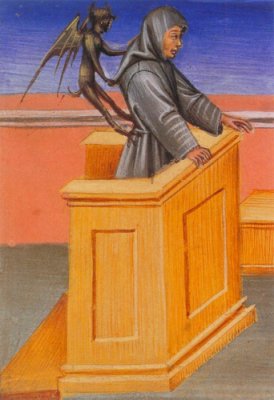|
The infernal Serpent; he it
was, whose guile
Stirred up with Envy and
Revenge, deceived
The Mother of Mankind, what
time his Pride
Had cast him out from Heaven, with all
his Host
Of Rebel Angels, by whose aid aspiring
To set himself in Glory above
his Peers,
He trusted to have equalled the most
High,
If he opposed; and with ambitious aim
Against the Throne and
Monarchy of God
Raised impious War in Heaven and
Battle proud
With vain attempt. Him the Almighty
Power
Hurled headlong flaming from the
Ethereal Sky
With hideous ruin and combustion down
To bottomless perdition,
there to dwell
In Adamantine Chains and penal Fire,
Who durst defy the Omnipotent
to Arms.
John Milton: Paradise Lost Book 1 |
|
The most familiar source of the
scene of the fallen angels in art
is in Revelation:
'And there was war in heaven: Michael and his angels fought against the
dragon; and the dragon fought and his angels, and prevailed not; neither
was their place found any more in heaven. And the great dragon was cast
out, that old serpent, called the Devil, and Satan, which deceiveth the
whole world: he was cast out into the earth, and his angels were cast
out with him.'
(Ch 12, v 7 - 9)
Another,
shorter description comes from Luke: 'And he said unto them, I beheld
Satan as lightning fall from heaven'. (Ch 10 v18)
These quotes leave many questions unanswered, and these have
preoccupied theologians from the earliest times. Why did the angels
revolt? From what hierarchical level did they come? How many were there?
Where did they end up after being cast from heaven?
I'll look at these topics below.
There are a number of images
in art of the fall of the rebel angels, but nothing I know of can
match Breugel, so I'm going to settle for that. I do
suspect that Breugel rather enjoyed himself when painting this. St
Michael, centre, with help from other angels, is dealing with a variety
of fallen angels, including fish-like ones and a rather beautiful one
that looks like a butterfly. The angel at the top left with the trumpet
is probably Gabriel, as that is an attribute of his.

Musées Royaux des Beaux-Arts,
Brussels
Why did the
angels revolt?
We know the chief of the fallen
angels as Satan (enemy) when in Hell, but as Lucifer (light giver)
before the fall. Paradise Lost talks of envy, pride and revenge,
suggesting he suffered from the egotism of many historical humans.
But of what was he envious? The non-canonical Wisdom of Solomon suggests
it was Humanity, the creation of God:
'For God
created man to be immortal, and made him to be an image of his own
eternity. Nevertheless through envy of the devil came death into the
world: and they that do hold of his side do find it.' (Ch 2 v23 - 24)
Lucifer could not accept that he
would have to serve humanity, or indeed Christ incarnated in human form.
Images of the Coronation of the Virgin, with the human Virgin centre
stage surrounded by subservient angels, would not have pleased Lucifer.
The Hierarchy of demons.
The number, seniority and individual
function of the fallen angels has obsessed theologians, professional and
amateur, since the earliest of times. King James the First wrote a
treatise called Daemonologie on this subject. He divided the
demons into four categories. The French Dominican Sebastien Michaelis
got into conversation with the demon he was exorcising from a nun. The
seemingly rather chatty
demon told him that, like the angelic hierarchy, there were nine
categories of demons in three hierarchies; this particular demon came
from the lowest category. Sebastien write it all down in the
appropriately titled Marvellous History.
As to how many there were, the
learned fifteenth century Spanish Friar and Bishop Alphonso de Spina
calculated the number to be 133,316,666,
representing one third of the original angelic host.
You may
well feel that this is all nonsensical stuff with no basis in the Bible
or serious theology. What it does illustrate, though, is the
fascination, or even obsession with the subject throughout history.
Where did the fallen angels end up?
The obvious answer is
Hell:
|
|
A further tale of misbehaving angels
on earth comes in Genesis Chapter 6:
There were giants in the earth in
those days; and also after that, when the sons of God came in unto the
daughters of men, and they bare children to them, the same became mighty
men which were of old, men of renown.
(v 6)
This isn't an easy passage to
interpret, but some suggest that it tells us that fallen angels came to
earth and had their way with beautiful women, sometimes thought to be
the daughters of Cain. The result of this was the birth of giants, known
as Nephelim. God was so outraged that the Flood was initiated.
Understandably, this story, which has echoes of the mythological tale of
Uranus and his association with Gaia, producing the Titans, does not
generally feature in religious art.
|




